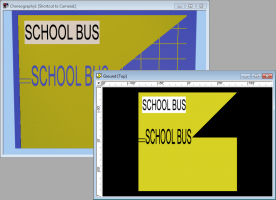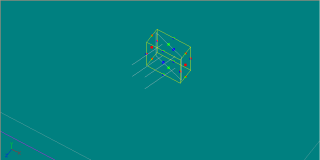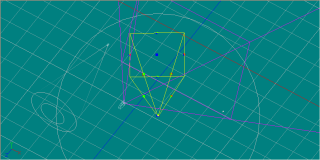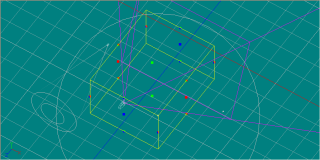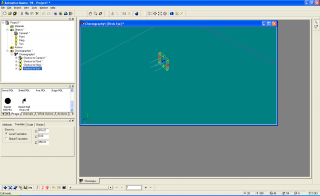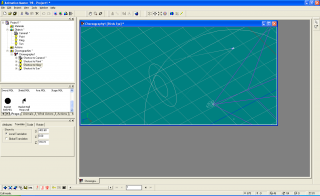-
Posts
1,182 -
Joined
-
Last visited
-
Days Won
1
Content Type
Profiles
Forums
Events
Everything posted by mouseman
-
You have some really good movement. I especially like the movement of the upper body when he lands, how the chest continues to rotate down as he compresses (kind of like the bouncing ball!). Some suggestions: 1. When rendering something for critique, it helps to have the frames burned in. There is a post effect that does that. [Edit: But I suppose that would only be available in a chor.] 2. It looks like this model uses the A:M 2000 rig. If you have a choice of rig, I suggest something newer, such as the excellent A:M 2008 or Squetch rigs, which have a separate control to lift up the heel. I'm not sure about LiteRig or the Anzovin TSM2 rig. The heel lifter makes it easier to deal with the toes sticking to the ground while the heel leaves the ground in those brief moments before the character is completely in the air; it would also make the landing on the toes and subsequent rolling down of the heel easier (notice how his toes slide between the frame they make contact and the next frame). If you don't have a choice of rig, you are forced to fight with the rig as you are doing here. 3. When he gets down into his squat at the 1/3 mark, his back is arched back. I think most people would be arched forward, as if part of a spring that is being compressed and ready to be sprung. They also tend to start being on their toes (not their heels) at this moment (hard to do on the A:M2000 rig). If you do arch the back forward, note that you will be moving part of his upper torso forward, so to maintain his center of gravity you may need to move his hips backwards enough so the character maintains balance. 4. You could add a wee bit of secondary motion in the head after he lands that lags behind the chest. But be careful, don't overdo the head movement. I really like how you are taking multiple attempts at this, trying different things on each attempt. I usually get caught up on tweaking the same thing, and what you are doing is probably much better for learning.
-
Not just on top, but over the top! I keep imagining these so-called tests are only meant to look like random experiments, but will actually all show up in some huge ingenious production some day.
-
It would be a great gag if they could remain there, but BLINK worriedly, and maybe look around.
-
Worked like a charm! Thanks!
-
Hmm, interesting. That's a good sign, I guess, although I don't know why it happens on my machine. I have 64-bit Windows 7 with Nvdia GeForce GTX 460M. The other thing is that the upper-left PNG is intended to display the letters in black, and then transparency allows the yellow to display. The lower right is the same thing except it's a TGA, and it works as I hoped it would. I included an HTML file that shows that the background shows through around the PNG, so browsers (at least Firefox) recognize the transparency as I would expect. I would prefer to use PNG for size sake, but at least TGA works.
-
Lesson: If you have transparency, use TGAs for decals, not PNGs. This is with PNG; one (with the white background) is set to "color", the other is set to "transparency" and causes part of the geometry not to display. I have a sample project that hopefully I will remember to submit this weekend and make sure it's not a duplicate. BusFrontTitle.zip
-
Hmm. Render straight to animated GIF would be a neat option.
-
Is "Global Axis" the same as "World Space"? If so, there was a difference: Sun light: Point light: I kept the camera angle identical between the shots, the only difference was World Space off (in the left view) and on (in the right view). There was no difference in the klieg light. There was just a single blue point on the opening of the light.
-
-
Looking really good. The only thing that stands out to me right now is that he seems to be a little off on center of gravity. He's leaning forward quite a bit during most of the animation and it's not clear how he's holding himself up. Other than that, you're getting beyond the place where I'm able to offer ideas for things to tweak, but Robcat has some interesting points.
-
A:M 98, 6.0e (right from the install disk). Thank goodness for virtualization. I hope this is what you were looking for. I just selected the light and hit the "N" key.
-
Very nice! Very good mood and movement! There are a lot of nice touches, such as the horn "bell" size throbbing and his foot tapping exactly on beat. It's very exciting seeing this progressing! A couple of things for consideration. I might be over-thinking it, and I don't play a wind or brass instrument, so take this all with a grain of salt. One suggestion is in between phrases (like the two near the beginning and one almost exactly half way through; I don't see frame numbers burned in so I can't refer to those), have him remove his mouth (slightly open) from the mouthpiece as if he's breathing, and then come back to it shortly before the next phrase starts. Also, at the end of the clip, he has a run of notes in a downward direction. A lot of times when there is a run like this, the musician is concentrating on getting all the notes just right. For a wind instrument, he is probably playing the game of managing how much breath he uses so he'll have enough while still getting the most volume out of it, cutting it as close as possible on a long phrase like near the end. For that last section, it might work to have him rocking his upper body slightly to the beat, starting out more upright and getting a little lower, as if he's straining slightly to use the remaining breath he has to still have a strong finish.
-
I'm imagining a short with a break room and a coffee shop as the sets ...
-
Wow, quite a realistic and detailed lower face. Look at those teeth! (The sunglasses hide the upper face.)
-
You will want to be a little careful assigning an IP address in the range that your router might give out addresses. A problem can happen when a new device comes online, and the DHCP server (in the router) gives out 198.162.1.5 to that new device, and there is a conflict with your existing device. There is usually a configuration value in the router to specify the range of DHCP addresses it will give out, frequently by default it is 1-50 or 1-100. One thing you can do is change the router to give out dynamic IP addresses beginning at 100, and reserve 2-99 for your static addresses (1 is usually the router itself).
-
I think in Bubba's case, VMWare has done the work of assigning an internally static IP address, and the easiest thing for him to do is to use one of those. Instructions for creating your own locally static IP address would be rather different for each system; I'd have no idea where to start for a Mac. "Laptops not very well suited for rendering" probably depends a lot on the laptop. Regardless, that's what some people (including myself) have to work with, and want to make the most of it.
-
Hi, bubba, ifconfig lists the network "interfaces" on your system. There is a version of it for most operating systems, sometimes with a different name (e.g. ipconfig on windows) and different options. I've read that it's suggested that you not use ifconfig to make changes on the Mac, since it is very low-level, and there are other configuration pieces that wouldn't get updated when making these changes. I'm not a Mac person, so I can't really say much about it; just wanted to warn you to tread carefully with making any changes. Here's a description of the interfaces, as far as I can tell from having used Windows and various Unix-like OSes: This is the internal interface. The 127.0.0.1 IP address for device "o0" is usually referred to as "localhost". It's always there, but the render server doesn't bind to it. Not sure what these are. This is your main IP address (192.168.1.5), probably automatically assigned by DHCP by your router. This can change if you have a laptop and, for example, take it to a coffee shop, or even if you reboot. Therefore it's a problem to use as the IP to connect to. These are not configured, and I'm not 100% sure what they are. I might guess that en1 is the wireless if en0 is the wired network, or vice versa. "fw0" is supposed to be "ethernet over fire-wire", but I've never used it. These interfaces come from VMWare. I believe the IP addresses will not change between boot-ups, or when moving from network to network. In practice, I've found these usable as stable IP addresses for render messengers on the same machine to connect to. In short, one of these addresses (192.168.144.1 or 172.16.58.1) would probably serve you well as an unchanging IP address for the render messengers to connect to.
-
I haven't used NetRender since before the 16 release. Back when I was trying out NetRender (for Bus Stop), I moved between multiple networks. I had problems starting it back up, even if I stopped all of the slaves, because my Laptop's IP address would change between home vs contract #1 vs contract #2. I have an extra IP address (thanks to VirtualBox, which installs a virtual network controller) that is usually unused, and I ended up pointing the server to a static IP address. Then I could easily stop the slaves, hibernate the computer, make it wake up at the new location, and restart the slaves and it worked pretty well. Bubba, you can find out a little more about your IP addresses (and which interfaces they are installed on) using "ifconfig -a". I don't know where ifconfig is on a Mac, but on most versions of Linux it is in /sbin/ifconfig.
-
Vivid imagery, and really good balance and layout between the text and image. Well done.
-
Quite stunning! Really good work!
-

Commentary tracks! Need BUS STOP Commentary tracks.
mouseman replied to robcat2075's topic in Work In Progress / Sweatbox
It's easy. Just jot out the points you want to make, practice it a few times, and give a go at recording it. You can probably do it in 10 minutes, including sending it off to Robcat! -
A grow op, maybe?
-
Wonderful mood! Very evocative! I agree with Nancy's suggestion. Lighting - maybe volumetric would make it look really neat! (Although that might not fit in with the look or might be computationally too slow.)
-
Wow, it's looking really good! I think it's getting pretty far along. A couple of reference videos, just in case you don't have enough already. Good observation regarding different subtleties for different walk speeds.
-

Animation WIP for a critique
mouseman replied to Bruce Del Porte's topic in Work In Progress / Sweatbox
Yes, of course, it's Sir Nigel but young! (Perhaps before his elevation to the knighthood?) Looking really good! The timing is really good now. Those efforts made a worthwhile difference. There only two very small suggestions that would hopefully only take 5 minutes: 1. Nigel's upper body and head are completely still/stiff from about frame 525 until frame 613. Maybe some kind of moving hold, or a little back-and-forth movement? 2. Also, when he leans into the pose around frame 634, it might be better if he leaned away from the camera a little bit, as if he were talking to the other side of the microphone and looking roughly in the direction of the camera. The head turn shortly after that turn is also a little mechanical is its steady rate.









